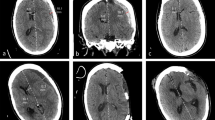Abstract
Background
Intracranial hemorrhage (ICH) is not an uncommon complication of end-stage renal disease (ESRD), and may be complicated by cerebral edema. Hemodialysis (HD) may induce rapid osmolar and fluid shifts, increasing brain water content with the potential to worsen cerebral edema. The dangers of HD in patients with acute ICH have only been highlighted in isolated reports.
Methods
Case series and review of relevant literature.
Results
Two patients with ESRD presented with acute ICH (one with putaminal hematoma, the other with bilateral subdural hematomas) and developed fatal/near-fatal herniation during HD, associated with malignant worsening of cerebral edema. Both had interruptions in dialysis schedule prior to index event. Both were awake initially, but developed cerebral herniation syndrome toward the end of index HD, confirmed on imaging with worsening edema and effaced basal cisterns. In one case, herniation was reversed with hypertonic saline and hyperventilation, but in the other, the patient progressed to brain death despite these measures. We contrast these cases with a young patient with ESRD and large basal ganglia ICH who had elevated ICPs on admission, but safely underwent continuous veno-venous HD.
Conclusions
Hemodialysis may worsen cerebral edema in the setting of ICH sufficient to precipitate cerebral herniation. Caution should be exercised when dialysing a patient with an acute mass lesion and reduced intracranial compliance, especially those in whom HD is new or not routine. Delaying HD till risk of edema is attenuated, or ensuring gradual urea removal (such as with continuous hemofiltration) may be advisable.


Similar content being viewed by others
References
Arieff AI, Massry SG, Barrientos A, Kleeman CR. Brain water and electrolyte metabolism in uremia: effects of slow and rapid hemodialysis. Kidney Int. 1973;4(3):177–87.
Walters RJ, Fox NC, Crum WR, Taube D, Thomas DJ. Haemodialysis and cerebral oedema. Nephron. 2001;87(2):143–7.
Bagshaw SM, Peets AD, Hameed M, Boiteau PJE, Laupland KB, Doig CJ. Dialysis disequilibrium syndrome: brain death following hemodialysis for metabolic acidosis and acute renal failure–a case report. BMC Nephrol. 2004;5:9.
Lin CM, Lin JW, Tsai JT, et al. Intracranial pressure fluctuation during hemodialysis in renal failure patients with intracranial hemorrhage. Acta Neurochir Suppl. 2008;101:141–4.
Silver SM, Sterns RH, Halperin ML. Brain swelling after dialysis: old urea or new osmoles? Am J Kidney Dis. 1996;28(1):1–13.
Trinh-Trang-Tan M-M, Cartron J-P, Bankir L. Molecular basis for the dialysis disequilibrium syndrome: altered aquaporin and urea transporter expression in the brain. Nephrol Dial Transplant. 2005;20(9):1984–8.
Arieff AI, Guisado R, Massry SG, Lazarowitz VC. Central nervous system pH in uremia and the effects of hemodialysis. J Clin Invest. 1976;58(2):306–11.
Brouns R, De Deyn PP. Neurological complications in renal failure: a review. Clin Neurol Neurosurg. 2004;107(1):1–16.
Yoshida S, Tajika T, Yamasaki N, et al. Dialysis dysequilibrium syndrome in neurosurgical patients. Neurosurgery. 1987;20(5):716–21.
Shaikh N, Louon A, Hanssens Y. Fatal dialysis disequilibrium syndrome: a tale of two patients. J Emerg Trauma Shock. 2010;3(3):300.
Caruso DM, Vishteh AG, Greene KA, Matthews MR, Carrion CA. Continuous hemodialysis for the management of acute renal failure in the presence of cerebellar hemorrhage. Case report. J Neurosurg. 1998;89(4):649–52.
Davenport A. Practical guidance for dialyzing a hemodialysis patient following acute brain injury. Hemodial Int. 2008;12(3):307–12.
Conflict of interest
The authors declare that they have no conflict of interest.
Author information
Authors and Affiliations
Corresponding author
Rights and permissions
About this article
Cite this article
Kumar, A., Cage, A. & Dhar, R. Dialysis-Induced Worsening of Cerebral Edema in Intracranial Hemorrhage: A Case Series and Clinical Perspective. Neurocrit Care 22, 283–287 (2015). https://doi.org/10.1007/s12028-014-0063-z
Published:
Issue Date:
DOI: https://doi.org/10.1007/s12028-014-0063-z




